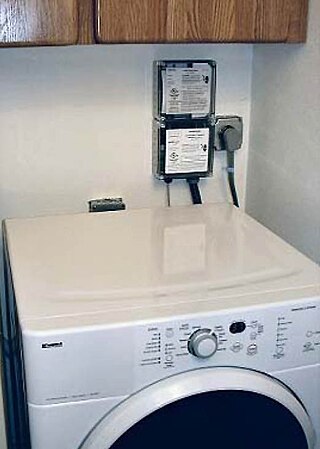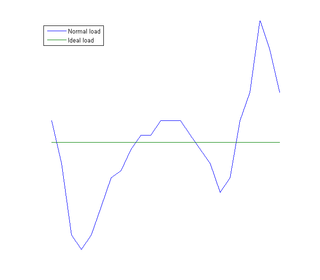
Automatic meter reading (AMR) is the technology of automatically collecting consumption, diagnostic, and status data from water meter or energy metering devices and transferring that data to a central database for billing, troubleshooting, and analyzing. This technology mainly saves utility providers the expense of periodic trips to each physical location to read a meter. Another advantage is that billing can be based on near real-time consumption rather than on estimates based on past or predicted consumption. This timely information coupled with analysis can help both utility providers and customers better control the use and production of electric energy, gas usage, or water consumption.

Demand response is a change in the power consumption of an electric utility customer to better match the demand for power with the supply. Until the 21st century decrease in the cost of pumped storage and batteries, electric energy could not be easily stored, so utilities have traditionally matched demand and supply by throttling the production rate of their power plants, taking generating units on or off line, or importing power from other utilities. There are limits to what can be achieved on the supply side, because some generating units can take a long time to come up to full power, some units may be very expensive to operate, and demand can at times be greater than the capacity of all the available power plants put together. Demand response, a type of energy demand management, seeks to adjust in real-time the demand for power instead of adjusting the supply.

A smart meter is an electronic device that records information—such as consumption of electric energy, voltage levels, current, and power factor—and communicates the information to the consumer and electricity suppliers. Such an advanced metering infrastructure (AMI) differs from automatic meter reading (AMR) in that it enables two-way communication between the meter and the supplier.
Nova Scotia Power Inc. is a vertically integrated electric utility in Nova Scotia, Canada. It is privately owned by Emera and regulated by the provincial government via the Nova Scotia Utility and Review Board (NSUARB). Nova Scotia Power Inc provides electricity to 520,000 residential, commercial and industrial customers in Nova Scotia.
A virtual power plant (VPP) is a system that integrates multiple, possibly heterogeneous, power sources to provide grid power. A VPP typically sells its output to an electric utility. VPPs allow energy resources that are individually too small to be of interest to a utility to aggregate and market their power. As of 2024, VPPs operated in the United States, Europe, and Australia.

Load management, also known as demand-side management (DSM), is the process of balancing the supply of electricity on the network with the electrical load by adjusting or controlling the load rather than the power station output. This can be achieved by direct intervention of the utility in real time, by the use of frequency sensitive relays triggering the circuit breakers, by time clocks, or by using special tariffs to influence consumer behavior. Load management allows utilities to reduce demand for electricity during peak usage times, which can, in turn, reduce costs by eliminating the need for peaking power plants. In addition, some peaking power plants can take more than an hour to bring on-line which makes load management even more critical should a plant go off-line unexpectedly for example. Load management can also help reduce harmful emissions, since peaking plants or backup generators are often dirtier and less efficient than base load power plants. New load-management technologies are constantly under development — both by private industry and public entities.

The smart grid is an enhancement of the 20th century electrical grid, using two-way communications and distributed so-called intelligent devices. Two-way flows of electricity and information could improve the delivery network. Research is mainly focused on three systems of a smart grid – the infrastructure system, the management system, and the protection system. Electronic power conditioning and control of the production and distribution of electricity are important aspects of the smart grid.
GridPoint is an American clean technology company based in Reston, Virginia, that provides energy management and sustainability services to enterprises and government agencies, such as electric utilities.
Sunrun Inc. is an American provider of photovoltaic systems and battery energy storage products, primarily for residential customers. The company was established in 2007 and is headquartered in San Francisco, California.

An electrical grid is an interconnected network for electricity delivery from producers to consumers. Electrical grids consist of power stations, electrical substations to step voltage up or down, electric power transmission to carry power over long distances, and finally electric power distribution to customers. In that last step, voltage is stepped down again to the required service voltage. Power stations are typically built close to energy sources and far from densely populated areas. Electrical grids vary in size and can cover whole countries or continents. From small to large there are microgrids, wide area synchronous grids, and super grids. The combined transmission and distribution network is part of electricity delivery, known as the power grid.

Itron, Inc. is an American technology company that offers products and services for energy and water resource management. It is headquartered in Liberty Lake, Washington, United States. The company's products measure and analyze electricity, gas and water consumption. Its products include electricity, gas, water and thermal energy measurement devices and control technology, communications systems, software, as well as managed and consulting services.

Google PowerMeter was a software project of Google's philanthropic arm, Google.org, to help consumers track their home electricity usage. It was launched on October 5, 2009, and ended on September 16, 2011. The development of the software was part of an effort by Google to invest in renewable energy, electricity grid upgrades, and other measures that would reduce greenhouse gas emissions. The software was designed to record the user's electricity usage in near real-time. Google partnered with various companies during the project.

Ingenu, formerly known as On-Ramp Wireless, is a provider of wireless networks. The company focuses on machine to machine (M2M) communication by enabling devices to become Internet of Things (IoT) devices.
Tropos Networks is a wireless mesh networking company that provides hardware, embedded software and network management application software for building large scale wireless networks. These networks are used by utilities, municipalities, public safety agencies, mines and others that need to communicate with fixed and mobile assets, as well as mobile workers, in the field. The company was founded in 2000 by Narasimha Chari, Devabhaktuni "Sri" Srikrishna, Christian Dubiel and Jonathan Goldenstein. It is headquartered in Sunnyvale, California. In June 2012, it was acquired by ABB Power Grids Group, now Hitachi Energy.
The OpenHAN standards for home networks was promoted by groups such as openAMI and UtilityAMI. Both efforts aim to standardize powerline networking interoperation from a utility point of view and ensure reliable communications co-extant with AC power outlets. Both utilities and vendors of home control have promoted such standards aggressively. The openHAN label usually denotes standards favored by the utilities, not other service providers. It should be distinguished from the openADR standards that were promoted to ensure open access to customer electricity use data by all service providers.
Smart grid policy in the United States refers to legislation and other governmental orders influencing the development of smart grids in the United States.
Enphase Energy, Inc. is an American energy technology company headquartered in Fremont, California, that develops and manufactures solar micro-inverters, battery energy storage, and EV charging stations primarily for residential customers. Enphase was established in 2006 and is the first company to successfully commercialize the solar micro-inverter, which converts the direct current (DC) power generated by a solar panel into grid-compatible alternating current (AC) for use or export. The company has shipped more than 48 million microinverters to 2.5 million solar systems in more than 140 countries.

Peter L. Corsell is an American technology entrepreneur, leader, and investor. A repeat entrepreneur in the sustainable energy industry, Corsell founded GridPoint in 2003, and Twenty First Century Utilities in 2015.
Green Charge Networks LLC is an energy storage company based in Santa Clara, California. Founded in 2009, Green Charge uses predictive software to try to reduce peak demand charges for businesses.
Transactive energy refers to the economic and control techniques used to manage the flow or exchange of energy within an existing electric power system in regards to economic and market based standard values of energy. It is a concept that is used in an effort to improve the efficiency and reliability of the power system, pointing towards a more intelligent and interactive future for the energy industry.










